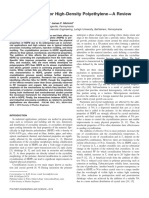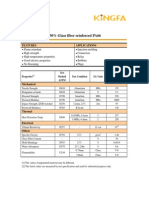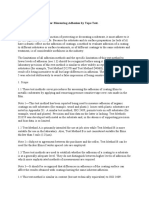Intrinsic Viscosity As Quality Control Parameter of PET: Relevant For: Polymers, Plastics, ISO 1628, PET
Intrinsic Viscosity As Quality Control Parameter of PET: Relevant For: Polymers, Plastics, ISO 1628, PET
Uploaded by
Paresh HadkarCopyright:
Available Formats
Intrinsic Viscosity As Quality Control Parameter of PET: Relevant For: Polymers, Plastics, ISO 1628, PET
Intrinsic Viscosity As Quality Control Parameter of PET: Relevant For: Polymers, Plastics, ISO 1628, PET
Uploaded by
Paresh HadkarOriginal Title
Copyright
Available Formats
Share this document
Did you find this document useful?
Is this content inappropriate?
Copyright:
Available Formats
Intrinsic Viscosity As Quality Control Parameter of PET: Relevant For: Polymers, Plastics, ISO 1628, PET
Intrinsic Viscosity As Quality Control Parameter of PET: Relevant For: Polymers, Plastics, ISO 1628, PET
Uploaded by
Paresh HadkarCopyright:
Available Formats
Intrinsic Viscosity as Quality Control Parameter of PET
Relevant for: Polymers, Plastics, ISO 1628, PET
PET is one of the most important polymers used for packaging materials in the world. Different
grades of PET are classified using the Intrinsic Viscosity, a parameter to calculate the polymer’s
molar mass. Lovis 2000 M with its implemented polymer software measures and calculates
polymer parameters automatically at the touch of a button.
The demand for reliable Intrinsic Viscosity
measurements is high as PET has to be characterized
in various fields:
Research & Development, where new polymers
are synthesized and characterized
PET suppliers, who want to control the quality
of their products
Process plants, who want to optimize their
conditions for constant production
Recycling facilities, that need to control the
properties of recycled PET
1 Intrinsic viscosity for quality control of PET
Dilute solution viscometry using Lovis 2000 M
One technique often used for quality control is dilute
PET(Polyethylene terephthalate) is a linear solution viscometry. Polymers are diluted in
thermoplastic with a wide range of use including appropriate solvents and the viscosity of the pure
fibers, textiles and of course as a packaging material. solvent is set in relation to the viscosity of the polymer
solution. This procedure yields the relative viscosity, a
The main indicator for the quality and the most basic parameter from which many others, including
important characteristic of PET is the value of its the Intrinsic Viscosity can be calculated.
Intrinsic Viscosity. The Intrinsic Viscosity is related to
the polymer’s molar mass and therefore reflects the The Lovis 2000 M is perfectly suited for determining
material’s melting point, crystallinity and tensile the properties of polymers using dilute solution
strength. The Intrinsic Viscosity is dependent upon the viscometry as it offers many features making
length of the polymer chains. The longer the polymer measurements easy and comfortable:
chains are, the more entanglements between chains
occur and therefore the viscosity value is higher. The
desired Intrinsic Viscosity of PET is dependent on its Polymer software for automatic calculation of
application and classified in different grades (see all desired polymer parameters
Table 1). Low sample/solvent consumption reducing
the contact with hazardous chemicals
Optional combination with sample changers
PET grade Intrinsic Viscosity [dL/g]
for enhanced throughput
Fiber grade 0.40 – 0.70 High chemical resistance
Film grade 0.70 – 1.00
Bottle grade 0.70 – 0.78 This report presents Intrinsic Viscosity measurements
Water and soft drink bottle grade 0.78 – 0.85 of PET used for bottle manufacturing of softdrinks.
Measuring settings and a detailed sample preparation
Table 1: Typical Intrinsic Viscosity values of different PET grades.
is given.
C72IA036EN-A page 1 of 3 www.anton-paar.com
2 Samples and sample preparation Tip: Sample preparation is a critical step, as errors
made here will lead to wrong results and/or bad
The Intrinsic Viscosity [mL/g] of three different PET repeatability.
raw forms for plastic bottle production was measured.
Samples and solvents are listed in Table 2.
Sample and chemicals Chemical Description 3 Measurement
Polyethylene terephthalate (PET), three
Sample
batches This section describes the instrument set-up and the
Dichloroacetic acid (DCA), for dissolving used method settings.
Solvent 1
the polymer and cleaning
Ethanol for removing the acid from the 3.1 Instrumental set-up
Solvent 2
system before drying
Table 2: Tested samples and chemicals used For measurements, a Lovis 2000 M in flow-through
mode was used.
Batch 1 (PET 1) and 2 (PET 2) were transparent
granulates with an approximate size of 4 mm, Capillary: 1.8 mm glass
whereas batch three (PET 3) was a white granulate Ball material: gold coated steel
with a size of approximately 2 mm.
O-rings: Kalrez
2.1 Sample preparation
A chemical resistance upgrade kit can be ordered,
The samples were prepared according to ISO 1628-5, including a batch of gold coated balls and Kalrez® O-
a common test-method for determining the viscosity of rings for enhanced chemical resistance.
thermoplasts.
0.250 g of the sample were weighed into a graduated
50 mL flask and the weight was noted down
(d= 0.1 mg, Table 1). A magnetic stirring bar and
approximately 25 mL of DCA were added and the
flask was closed. For dissolving, the sample was
stirred for 60 min on a hot plate – set to 100 °C – with
stirring function. After approximately 60 min still some
residues were visible and therefore the dissolving
process was extended to 120 min in total. The flask
was then removed from the hot plate and cooled to
room temperature.
Tip: Dissolving times can vary depending on polymer
types and size of the material. Always check if the
polymer solution is clear and that no residues are
Figure 1: Lovis 2000 M in flow- through filling mode
visible anymore.
After removing the stirring bar the flask was filled with
DCA to a final volume of 50 mL resulting in a final 3.2 Method settings
concentration of 0.005 g/mL. To avoid concentration
gradients the flask is shaken properly before the Measurement mode: Polymer
measurements. The solvent blank was processed in Temperature: 25 °C
the same way as the sample. Each of the samples Measurement cycles: 3
was dissolved once.
Manual angle: 30°
Measuring distance: long
Variation Coefficient: 0.35 %
C72IA036EN-A page 2 of 3 www.anton-paar.com
3.3 Measurement and results 4 Conclusion
Each polymer solution was filled and measured in
The Lovis 2000 M is the perfect solution for
triplicate with cleaning inbetween. Out of the runtimes
determining the grade of PET through Intrinsic
of the pure solvent and the polymer solution all
Viscosity measurements.
polymer parameters were automatically calculated.
For more measuring comfort an Xsample™ 340 can
be added to the measuring assembly. This one
Table 3 displays the results for the three PET batches syringe sample changer enables automatic filling and
expressed in relative and Intrinsic Viscosity [mL/g]. cleaning with up to two cleaning agents and reduces
the contact of the user with hazardous chemicals.
Relative viscosity Intrinsic Viscosity
Sample type
[Mean ± 1 σ (RSD %)] [mL/g,mean ± 1 σ (RSD %)]
PET 1 1.48 ± 0.001 (0.07) 82.1 ± 0.1 (0.12)
PET 2 1.49 ± 0.001 (0.07) 85.5 ± 0.1 (0.12)
PET 3 1.50 ± 0.001 (0.07) 85.0 ± 0.1 (0.12)
Table 3: Relative and Intrinsic Viscosity of the raw material and the
end product
To check for the measuring quality two parameters
are of interest, namely the FW/BW deviation and the
Variation Coefficient (see Table 4).
The FW/BW deviation gives the deviation
between the runtime of a forward Figure 2: Lovis 2000 M + Xsample™ 340
measurement (e.g. +70° angle) and the
subsequent backward measurement (e.g. -70°
angle).
5 References
The Variation Coefficient gives the runtime
repeatability in between the measurement 1. ISO 1628-5, Plastics - Determination of the
cycles. viscosity of polymers in dilute solution using glass
capillary viscometers - Part 5: Thermoplastic polyester
(TP) homopolymers and copolymers
Variation coefficient FW/BW deviation
Sample type 2. Materials Science and Engineering: Concepts,
[%] [%]
Methodologies, Tools, and Applications, 2017
PET 1 ≤ 0.08 ≤ 1.37
PET 2 ≤ 0.05 ≤ 1.37
Contact Anton Paar GmbH
PET 3 ≤ 0.02 ≤ 1.37
Table 4: Lovis Variation coefficient and FW/BW deviation as quality support-visco@anton-paar.com
indicators of measurement
support-lps@anton-paar.com
Tip: Limits for the FW/BW deviation are implemented
inside of the instrument. If they are exceeded, a
warning will appear on screen. The limit for the
Variation Coefficient can be set. Per default it is set to
0.35 % for polymer solutions.
C72IA036EN-A page 3 of 3 www.anton-paar.com
You might also like
- AQA Chemistry Paper 1 2023Document36 pagesAQA Chemistry Paper 1 2023B朗No ratings yet
- Iso 11358 1 2022Document10 pagesIso 11358 1 2022wave412163.comNo ratings yet
- Determination of Moisture in Plastics by Relative Humidity SensorDocument4 pagesDetermination of Moisture in Plastics by Relative Humidity Sensorsagar thakkarNo ratings yet
- Measuring Thermal Crystallinity in PET: Spe Antec Indianapolis 2016Document5 pagesMeasuring Thermal Crystallinity in PET: Spe Antec Indianapolis 2016Silviani SilvyNo ratings yet
- Quantification of The Maleic Anhydride Grafted Onto Polypropylene by Chemical and Viscosimetric Titrations, and FTIR Spectros PDFDocument11 pagesQuantification of The Maleic Anhydride Grafted Onto Polypropylene by Chemical and Viscosimetric Titrations, and FTIR Spectros PDFThinh DangNo ratings yet
- The All New Bottle-to-Bottle Recycling Technology VACUNITEDocument31 pagesThe All New Bottle-to-Bottle Recycling Technology VACUNITECao LongNo ratings yet
- Iso 1628 2 2020Document10 pagesIso 1628 2 2020Yousef HalasehNo ratings yet
- Ecovio: Biologically Degradable Solutions For Extrusion ApplicationsDocument24 pagesEcovio: Biologically Degradable Solutions For Extrusion ApplicationsFelipeBohorquezNo ratings yet
- TPO Coated PP Fabrics and Their ApplicationsDocument14 pagesTPO Coated PP Fabrics and Their Applicationsrejorama100% (1)
- Brightness Color MeterDocument4 pagesBrightness Color MeterkmacleonNo ratings yet
- Astm D4603 - IvDocument4 pagesAstm D4603 - Ivram100% (1)
- Comparative Techniques For Molecular Weight EvaluationDocument6 pagesComparative Techniques For Molecular Weight EvaluationMaria Emilia Vazquez100% (2)
- Determination of Structural Features in Polyolefins and Polyolefin Copolymers by Infrared Spectrophotometry (FT-IR)Document3 pagesDetermination of Structural Features in Polyolefins and Polyolefin Copolymers by Infrared Spectrophotometry (FT-IR)samehNo ratings yet
- Iso 10545 14 1995Document9 pagesIso 10545 14 1995nazrul islamNo ratings yet
- THERMAL PROPERTIES OF POLYMER (Update)Document38 pagesTHERMAL PROPERTIES OF POLYMER (Update)Vĩ Lê QuangNo ratings yet
- Polymers: A Review of Bioplastics and Their Adoption in The Circular EconomyDocument26 pagesPolymers: A Review of Bioplastics and Their Adoption in The Circular EconomyLIYA ASKARNo ratings yet
- Plastic StandardsDocument10 pagesPlastic StandardsMarian BelmisNo ratings yet
- Apparent Bending Modulus of Plastics by Means of A Cantilever BeamDocument6 pagesApparent Bending Modulus of Plastics by Means of A Cantilever Beamuzzy2No ratings yet
- Determining The Density of Polymers Used in GeonetsDocument1 pageDetermining The Density of Polymers Used in GeonetsLuciano SalituriNo ratings yet
- Oil Content of Petroleum Waxes: Standard Test Method ForDocument7 pagesOil Content of Petroleum Waxes: Standard Test Method ForHida Al-FithriNo ratings yet
- Astm D 721Document3 pagesAstm D 721yogenm100% (1)
- Attachment For Q3 in Assignment #3 DSR Test Procedure (AASHTO T 315)Document10 pagesAttachment For Q3 in Assignment #3 DSR Test Procedure (AASHTO T 315)Kamaluddin KamalNo ratings yet
- Science of Compostable Polymers T-Pitzi BASFDocument20 pagesScience of Compostable Polymers T-Pitzi BASFThanh Linh NguyenNo ratings yet
- Nucleating Agents For High-Density Polyethylene-A ReviewDocument14 pagesNucleating Agents For High-Density Polyethylene-A ReviewCao TúNo ratings yet
- Astm D127 - 87Document2 pagesAstm D127 - 87mpisjrkkhtoiiqfsuuNo ratings yet
- Astm D2765 - 2011Document7 pagesAstm D2765 - 2011sh.jahanyar.apcNo ratings yet
- Application of Rheology To PolymersDocument6 pagesApplication of Rheology To PolymersEhteshamul IslamNo ratings yet
- Ta Astm-6083Document8 pagesTa Astm-6083lthyaguNo ratings yet
- Polymer Rheology and Morphology Part 2Document35 pagesPolymer Rheology and Morphology Part 2AmyNo ratings yet
- PA66-RG301: Flame Retardant, 30% Glass Fiber Reinforced PA66Document2 pagesPA66-RG301: Flame Retardant, 30% Glass Fiber Reinforced PA66watnaNo ratings yet
- ISO 7765 Impact-Test FilmDocument12 pagesISO 7765 Impact-Test FilmyyNo ratings yet
- Polyethylene Demand & SupplyDocument4 pagesPolyethylene Demand & Supplysadam_madas2050% (2)
- (2022) Restabilization - 30 Years of Research For Quality Improvement of Recycled Plastics Review-RudolfDocument19 pages(2022) Restabilization - 30 Years of Research For Quality Improvement of Recycled Plastics Review-RudolfwalterNo ratings yet
- 18-F1927.29667-1 OtrDocument6 pages18-F1927.29667-1 OtrBruna Elias100% (1)
- 2007 Natural Polymer CharacterizationDocument4 pages2007 Natural Polymer CharacterizationermashuhadahrNo ratings yet
- 09C Polymer Structure and Properties (2.5 MB)Document22 pages09C Polymer Structure and Properties (2.5 MB)FâtïMâ ZâhřæNo ratings yet
- SDT - Agriculture - Greenhouse Film (XP Inc)Document58 pagesSDT - Agriculture - Greenhouse Film (XP Inc)Mulsa KTGNo ratings yet
- Iso 527 2 2012 en PDFDocument6 pagesIso 527 2 2012 en PDFQiang WangNo ratings yet
- Q Lab Correlación Entre ASTM D 7869 e Intemperismo ExteriorDocument89 pagesQ Lab Correlación Entre ASTM D 7869 e Intemperismo ExteriorJuan Angel DechimaNo ratings yet
- ASTM D2228 04 - Standard Test Method For Rubber Property-Relative Abrasion Resistance by Pico Abrader MethodDocument9 pagesASTM D2228 04 - Standard Test Method For Rubber Property-Relative Abrasion Resistance by Pico Abrader MethodAndre Rodriguez Spirim100% (1)
- Astm D2196-20Document2 pagesAstm D2196-20MathaiosVNo ratings yet
- Properties of EVM Compounds in Relation To The Vinyl Acetate Content of The PolymerDocument10 pagesProperties of EVM Compounds in Relation To The Vinyl Acetate Content of The PolymerabiliovieiraNo ratings yet
- ASTM D3359 Standard Test Methods For Measuring Adhesion by Tape TestDocument2 pagesASTM D3359 Standard Test Methods For Measuring Adhesion by Tape TestEdgarDavidDiazCamposNo ratings yet
- Correlating Melt Rheology of PET To Solution Intrinsic ViscosityDocument2 pagesCorrelating Melt Rheology of PET To Solution Intrinsic ViscosityIgor MedeirosNo ratings yet
- Study of The Production of Polyesters For PU at Pilot Plant Scale PDFDocument76 pagesStudy of The Production of Polyesters For PU at Pilot Plant Scale PDFCarlotta C.No ratings yet
- WWW Fujisilysia Com Technology ApplicationsDocument4 pagesWWW Fujisilysia Com Technology ApplicationsArnab BaruaNo ratings yet
- Reclaim RubberDocument40 pagesReclaim RubberMathur Subramaniam BalasundaramNo ratings yet
- D2843 16 PDFDocument9 pagesD2843 16 PDFFernando Da RosNo ratings yet
- ISO 15213-2 2023 Enumeration of Clostridium Perfringens by Colony-Count TechniqueDocument52 pagesISO 15213-2 2023 Enumeration of Clostridium Perfringens by Colony-Count TechniqueMarina Martins NascimentoNo ratings yet
- As ISO 16929-2008 Plastics - Determination of The Degree of Disintegration of Plastic Materials Under DefinedDocument8 pagesAs ISO 16929-2008 Plastics - Determination of The Degree of Disintegration of Plastic Materials Under DefinedSAI Global - APACNo ratings yet
- Astm d6392Document6 pagesAstm d6392Talca CalderónNo ratings yet
- Grafting of Maleic Anhydride On Polypropylene by Reactive Extrusion - Effect of Maleic Anhydride and Peroxide Concentrations On Reaction Yield and Product CharacteristicsDocument10 pagesGrafting of Maleic Anhydride On Polypropylene by Reactive Extrusion - Effect of Maleic Anhydride and Peroxide Concentrations On Reaction Yield and Product CharacteristicsShella Putri RahayuNo ratings yet
- Characterization and Ageing Study of PLA Films Plasticized With Oligomeric Lactic Acid 2013Document8 pagesCharacterization and Ageing Study of PLA Films Plasticized With Oligomeric Lactic Acid 2013TOUFIKNo ratings yet
- GMW14125 2019Document27 pagesGMW14125 2019廖健翔No ratings yet
- D 2684 PDFDocument5 pagesD 2684 PDFjai soniNo ratings yet
- Automated Titration of The Hydroxyl Number According To ASTM E1899 and EN ISO 4629-2Document8 pagesAutomated Titration of The Hydroxyl Number According To ASTM E1899 and EN ISO 4629-2xibs2009No ratings yet
- Astm DDocument6 pagesAstm DSaurabhNo ratings yet
- Nitoflor SL1000: Flow Applied, 0.5 - 1.5mm Thick Epoxy Resin Based Floor Topping UsesDocument4 pagesNitoflor SL1000: Flow Applied, 0.5 - 1.5mm Thick Epoxy Resin Based Floor Topping UsestalatzahoorNo ratings yet
- Characterization of Polymer Blends: Miscibility, Morphology and InterfacesFrom EverandCharacterization of Polymer Blends: Miscibility, Morphology and InterfacesNo ratings yet
- Astm D7409 15 2020Document2 pagesAstm D7409 15 20201984garunNo ratings yet
- Astm D4603 03Document2 pagesAstm D4603 03joseniltonNo ratings yet
- Fiber and YarnDocument20 pagesFiber and YarnParesh HadkarNo ratings yet
- Statistical Analyses and Predicting TheDocument9 pagesStatistical Analyses and Predicting TheParesh HadkarNo ratings yet
- Com-4 and Elite Yarns - Compact SpinningDocument10 pagesCom-4 and Elite Yarns - Compact SpinningParesh HadkarNo ratings yet
- Fibre Dynamics in The Revolving-Flats Card A Critical ReviewDocument23 pagesFibre Dynamics in The Revolving-Flats Card A Critical ReviewParesh HadkarNo ratings yet
- Card ClothingDocument9 pagesCard ClothingParesh HadkarNo ratings yet
- Loan Amount Tenor in Years Interest Rate Per AnnumDocument1 pageLoan Amount Tenor in Years Interest Rate Per AnnumParesh HadkarNo ratings yet
- Shortcut Keys Document: General ShortcutsDocument2 pagesShortcut Keys Document: General ShortcutsParesh HadkarNo ratings yet
- Astm Volume 15 01Document8 pagesAstm Volume 15 01mohamed moradNo ratings yet
- Traducir Y Resolver El Siguiente Cuestionario:: Hevea Rubber?Document1 pageTraducir Y Resolver El Siguiente Cuestionario:: Hevea Rubber?Danny HTNo ratings yet
- Chemistry Investigatory Project 2Document21 pagesChemistry Investigatory Project 2Carl JhonsonNo ratings yet
- Everlube 620 ATDSDocument2 pagesEverlube 620 ATDSValentinNo ratings yet
- Chemistry ProjectDocument10 pagesChemistry Projectadityasinhchauhan001No ratings yet
- Fosroc Nitoflor FC150: Constructive SolutionsDocument4 pagesFosroc Nitoflor FC150: Constructive SolutionsVincent JavateNo ratings yet
- 1 - To Identify Given Polymeric Material Through Crude Method.Document27 pages1 - To Identify Given Polymeric Material Through Crude Method.Farwa NaeemNo ratings yet
- Developing Eco-Friendly Curatives For Rubber Compounds: TechnicalDocument5 pagesDeveloping Eco-Friendly Curatives For Rubber Compounds: TechnicalKENo ratings yet
- 12th M3 Batch Part Test Syllabus Planner Nov & Dec - 24Document1 page12th M3 Batch Part Test Syllabus Planner Nov & Dec - 24gadgetworld0896No ratings yet
- Get Introduction To Polymer Chemistry, Fourth Edition Carraher Jr. Free All ChaptersDocument49 pagesGet Introduction To Polymer Chemistry, Fourth Edition Carraher Jr. Free All Chaptersrossanpike100% (5)
- B SC in Footwear Engineering Curriculum ILET DUDocument103 pagesB SC in Footwear Engineering Curriculum ILET DUAl-amin IslamNo ratings yet
- Ahlstrom Laboratoty Test Filter PaperDocument6 pagesAhlstrom Laboratoty Test Filter PaperHoang LeNo ratings yet
- Indian National Junior Science Olympiad Solved Paper 2013Document23 pagesIndian National Junior Science Olympiad Solved Paper 2013Vani datalyzerNo ratings yet
- 1 s2.0 S001085451500065X MainDocument45 pages1 s2.0 S001085451500065X MainJarosław KaszewskiNo ratings yet
- Tri-ACT® 1820: Safety Data SheetDocument13 pagesTri-ACT® 1820: Safety Data SheetEDUARDONo ratings yet
- Chem CH 12 NIE Premium NOtesDocument22 pagesChem CH 12 NIE Premium NOtesansarahmad6931No ratings yet
- Equilibrium Class 11 Notes Chemistry Chapter 7Document11 pagesEquilibrium Class 11 Notes Chemistry Chapter 7Kanishk Ranjit100% (1)
- Introduction-to-ChemistryDocument38 pagesIntroduction-to-ChemistryEGAS JAYSON RABENo ratings yet
- 26.7.2024 SR CBSE PRE FINAL-1 CHEMISTRYDocument9 pages26.7.2024 SR CBSE PRE FINAL-1 CHEMISTRYatharv soorajNo ratings yet
- Extremophiles 2004 PDFDocument149 pagesExtremophiles 2004 PDFChandraprasad S RajanganNo ratings yet
- Carbon and Its Compounds Study Based Questions....Document16 pagesCarbon and Its Compounds Study Based Questions....girija.shekar1990No ratings yet
- Chain TransferDocument2 pagesChain TransferNEERU GIRINo ratings yet
- Gasoline TreatmentDocument9 pagesGasoline Treatmentvivek vardhanNo ratings yet
- CBSE - X Class General Science Prefinal - II (SET-1) QP 2023-24Document8 pagesCBSE - X Class General Science Prefinal - II (SET-1) QP 2023-24anitharohith9No ratings yet
- B.Pharm - UofM - CBCS - Scheme and Syllabus - PCI - 2019-20 - 27062019Document175 pagesB.Pharm - UofM - CBCS - Scheme and Syllabus - PCI - 2019-20 - 27062019monika1983007No ratings yet
- Boiler Best PracticesDocument75 pagesBoiler Best PracticesErico Haryanto LumbanrajaNo ratings yet
- Viroguard Sanitizer SDS-WatermartDocument7 pagesViroguard Sanitizer SDS-WatermartIshara VithanaNo ratings yet
- Review of Related Literature: Et Al., 2000) - As Per Philippine Statistics Authority (PSA), During The PeriodDocument42 pagesReview of Related Literature: Et Al., 2000) - As Per Philippine Statistics Authority (PSA), During The PeriodCamille BuendiaNo ratings yet
- 11. The Alkali MetalsDocument33 pages11. The Alkali MetalsYasmine AdjadjNo ratings yet
































































































